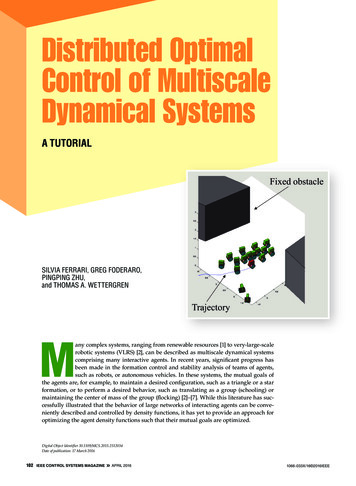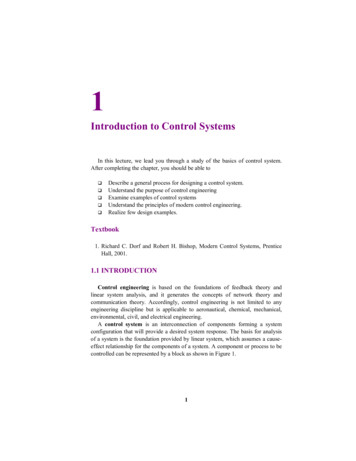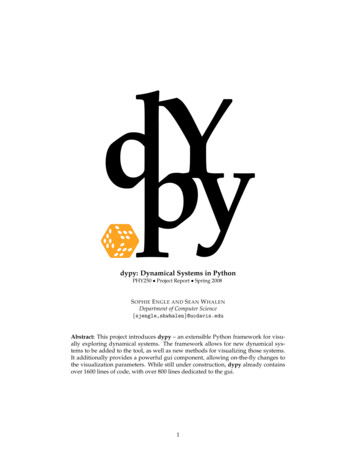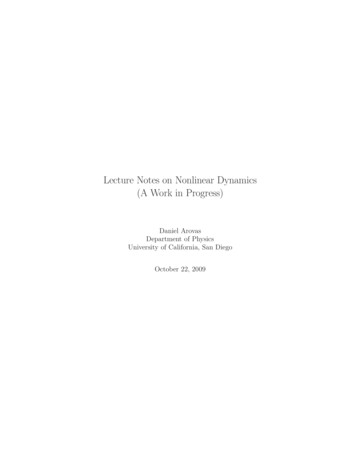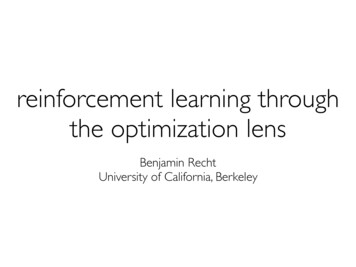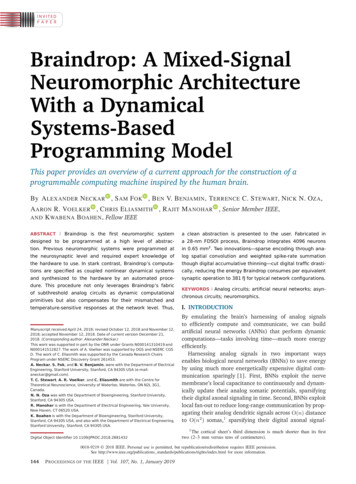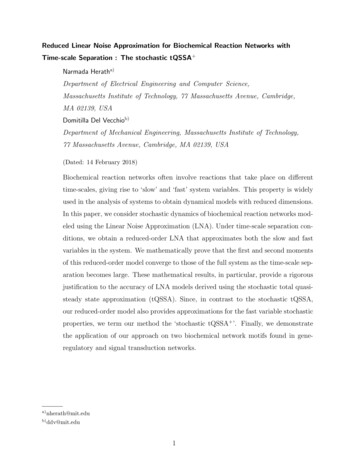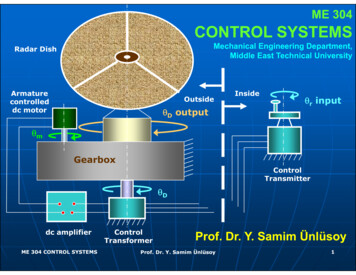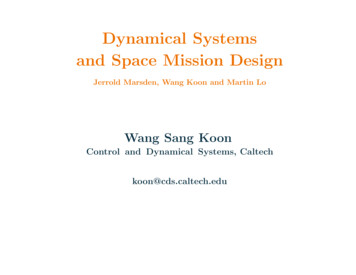
Transcription
Dynamical Systemsand Space Mission DesignJerrold Marsden, Wang Koon and Martin LoWang Sang KoonControl and Dynamical Systems, Caltechkoon@cds.caltech.edu
Halo Orbit and Its ComputationI From now on, we will focus on 3D CR3BP.I We will put more emphasis on numerical computations,especially issues concerning halo orbit missions,such as Genesis Discovery MissionI Outline of Lecture 5A and 5B: Importance of halo orbits. Finding periodic solutions of the linearized equations. Highlights on 3rd order approximation of a halo orbit. Using a textbook example to illustrate Lindstedt-Poincaré method. Use L.P. method to find a 3rd order approximationof a halo orbit. Finding a halo orbit numerically via differential correction. Orbit structure near L1 and L2
Importance of Halo Orbits: Genesis Discovery MissionI Genesis spacecraft will collect solar wind from a L1 halo orbit for 2 years, return those samples to Earth in 2003 for analysis.I Will contribute to understanding of origin of Solar system.1E 060L1L25000000zy (km)500000-5000001E 061E 06-1E 060x500000y-1E 0601E 06500000500000L1L2z (km)1E 06z (km)1E 060-500000-500000-1E 06-1E 06-1E 060x (km)1E 06-1E 0601E 06y (km)ZY-1E 06-500000x (km)00X
Important of Halo Orbits: Genesis Discovery MissionI A L1 halo orbit (1.5 million km from Earth) provides uninterruptedaccess to solar wind beyond Earth’s magnetoshphere.1E 060L1L25000000zy (km)500000-5000001E 061E 06-1E 060x500000y-1E 0601E 06500000500000L2z (km)1E 06z (km)1E 06L10-500000-500000-1E 06-1E 06-1E 060x (km)1E 06Y-1E 06-500000x (km)00-1E 0601E 06y (km)ZX
Importance of Halo Orbits: ISEE-3 MissionI Since halo orbit is ideal for studying solar effects on Earth, NASAhas had and will continue to have great interest in these missions.I The first halo orbit mission, ISEE-3, was launched in 1978.I ISEE-3 spacecraft monitored solar wind and other solar-inducedphenomena, such as solar radio bursts and solar flares,about a hour prior to disturbance of space enviroment near Earth.
Importance of Halo Orbits: Terrestial Planet FinderI JPL has begun studies of a TPF misson at L2 involving4 free flying optical elements and a combiner spacecraft.I Interferometry: achieve high resolution by distributingsmall optical elements along a lengthy baseline or pattern.I Look into using a L2 halo orbit and its nearby quasi-halo orbitsfor formation flight.
Importance of Halo Orbits: Terrestial Planet FinderI The L2 option offer several advantages: Additional spacecraft can be launched into formation later. The L2 offers a larger payload capacity. Communications are more efficient at L2. Observations and mission operations are simpler at L2.
Importance of Halo Orbits: 3D Dynamical ChannelsI In 3D dynamical channels theory,invariant manifolds of a solid torus of quasi-halo orbits could playsimilar role as invariant manifold tubes of a Lyapunov orbit.I Halo, quasi-halos and their invariant manifolds could be key in understanding material transport throughout Solar system, constructing 3D orbits with desired characteristics.Unstable0.06Forbidden g frame)0.04Unstable-0.04ManifoldL1 en Region0.940.96x (rotating frame)0.981
3D Equations of MotionI Recall equations of CR3BP:Ẍ 2Ẏ ΩXŸ 2Ẋ ΩYZ̈ ΩZ 1.where Ω (X 2 Y 2)/2 (1 µ)d 1 µd12S/Czd2Ed1y1 µSµx
3D Equations of MotionI Equations for satellite moving in vicinity of L1 can be obtained bytranslating the origin to the location of L1:x (X 1 µ γ)/γ,y Y /γ,z Z/γ,where γ d(m2, L1)I In new coordinate sytem, variables x, y, z are scale so that thedistance between L1 and small primary is 1.I New independent variable is introduced such that s γ 3/2t.y (nondimensional units, rotating frame)comet1L40.50L3L1SJL2mJ µmS 1 - µ-0.5L5-1Jupiter's orbit-1-0.500.51x (nondimensional units, rotating frame)
3D Equations of MotionI CR3BP equations can be developed using Legendre polynomial Pn Xxnẍ 2ẏ (1 2c2)x cnρ Pn( ) xρn 3 Xxncnρ Pn( )ÿ 2ẋ (c2 1)y yρn 3 Xxncnρ Pn( )z̈ c2z zρn 3γ n 1) ).where ρ x2 y 2 z 2, and cn γ 3(µ ( 1)n(1 µ)( 1 γ Useful if successive approximation solution procedure is carriedto high order via algebraic manipulation software programs.
Analytic and Numerical Methods: OverviewI Lack of general solution motivated researchers to developsemi-analytical method.I ISEE-3 halo was designed in this way.See Farquhar and Kamel [1973], and Richardson [1980].I Linear analysis suggestedexistence of periodic (and quasi-periodic) orbits near L1.I 3rd order approximation, using Lindstedt-Poincaré method,provided further insight about these orbits.I Differential corrector produced the desired orbitusing 3rd order solution as initial guess.
Periodic Solutions of Linearized EquationsI Periodic nature of solution can be seen in linearized equations:ẍ 2ẏ (1 2c2)x 0ÿ 2ẋ (c2 1)y 0z̈ c2z 0I The z-axis solution is simple harmonic, does not depend on x or y.I Motion in xy-plane is coupled, has ( α, iλ) as region0.5L1 JS0L2LZero velocity curvebounding forbiddenregion-0.5-1Jupiterregion-1-0.500.51x (nondimensional units, rotating frame)(a)x (nondimensional units, rotating frame)(b)y (nondimensional units, rotating frame)y (nondimensional units, rotating frame)I General solutions are unbounded, but there is a periodic solution.
Periodic Solutions of Linearized EquationsI Linearized equations has a bounded solution (Lissajous orbit)x Ax cos(λt φ)y kAx sin(λt φ)z Az sin(νt ψ)with k (λ2 1 2c2)/2λ. (λ 2.086, ν 2.015, k 3.229.)I Amplitudes, Ax and Az , of in-plane and out-of-plane motioncharacterize the size of orbit.
Periodic Solutions of Linearized EquationsI If frequencies are equal (λ ν), halo orbit is produced.I But λ ν only when amplitudes Ax and Az are large enough thatnonlinear contributions become significant.I For ISEE3 halo, Az 110, 000 km,Ax 206, 000 km and Ay kAx 665, 000 km.
Halo Orbits in 3rd Order ApproximationI Halo orbit is obtained only when amplitudes Ax and Az are largeenough that nonlinear contributions make λ ν.I Lindstedt-Poincaré procedure has been used to find periodic solution for a 3rd order approximation of PCR3BP system.3ẍ 2ẏ (1 2c2)x c3(2x2 y 2 z 2)2 2c4x(2x2 3y 2 3z 2) o(4),3ÿ 2ẋ (c2 1)y 3c3xy c4y(4x2 y 2 z 2) o(4),23z̈ c2z 3c3xz c4z(4x2 y 2 z 2) o(4).2I Notice that for periodic solution, x, y, z are o(Az ) with Az 1in normalized unit.
Halo Orbits in 3rd Order ApproximationI Lindstedt-Poincaré method: It is a successive approximation procedure. Periodic solution of linearized equation (with λ ν) will formthe first approximation. Richardson used this method to find the 3rd order solution.x a21A2x a22A2z Ax cos τ1 (a23A2x a24A2z ) cos 2τ1 (a31A3x a32AxA2z ) cos 3τ1,y kAx sin τ1 (b21A2x b22A2z ) sin 2τ1 (b31A3x b32AxA2z ) sin 3τ1,z δmAz cos τ1 δmd21AxAz (cos 2τ1 3) δm(d32Az A2x d31A3z ) cos 3τ1.where τ1 λτ φ and δm 2 m, m 1, 3. Details will be given later. Here, we will provide some highlights.
Halo Orbit Amplitude Constraint RelationshipI For halo orbits, we have amplitude constraint relationshipl1A2x l2A2z 0. For halo orbits about L1 in Sun-Earth system,l1 1.59650314, l2 1.740900800 and 0.29221444425. Halo orbit can be characterized completely by Az .ISEE-3 halo orbit had Az 110, 000 km.
Halo Orbit Amplitude Constraint RelationshipI For halo orbits, we have amplitude constraint relationshipl1A2x l2A2z 0. Minimim value for Ax to have a halo orbit (Az 0) isp /l1 ,which is about 200, 000 km (14% of normalized distance).
Halo Orbit Phase-angle RelationshipI Bifurcation manifests through phase-angle relationshipψ φ mπ/2,m 1, 3. 2 solution branches are obtained according towhether m 1 or m 3.
Halo Orbit Phase-angle RelationshipI Bifurcation manifests through phase-angle relationship: For m 1, Az 0. Northern halo. For m 3, Az 0. Southern halo. Northern & southern halos are mirror images across xy-plane.
Lindstedt-Poincaré Method: Duffing EquationI To illustrate L.P. method, let us study Duffing equation: First non-linear approximation of pendulum equation(with λ 1)q̈ q q 3 0. For 0, it has a periodic solutionq a cos tif we assume the initial condition q(0) a, q̇(0) 0. For 6 0, suppose we would like to look fora periodic solution of the form Xq nqn(t) q0(t) q1(t) 2q2(t) · · ·n 0
Lindstedt-Poincaré Method: Duffing EquationI Finding a periodic solution for Duffing equation: By substituting and equating terms having same power of ,we have a system of successive differential equations:q̈0 q0 0,q̈1 q1 q03,q̈2 q2 3q02q1,and etc. Then q0 acos t, for q0(0) a, q̇(0) 0. Since1 3333q̈1 q1 q0 a cos t a (cos 3t 3cos t),4the solution has a secular term3 31 3q1 a t sin t a (cos 3t cos t).832
Lindstedt-Poincaré Method: Duffing EquationI Due to presence of secure terms, naive method such as expansionsof solution in a power series of would not work.I To avoid secure terms, Lindstedt-Poincaré method Notices that non-linearity alters frequency λ(corr. to linearized system) to λω( ) (λ 1 in our case). Introduce a new independent variable τ ω( )t:t τ ω 1 τ (1 ω1 2ω2 · · · ). Expand the periodic solution in a power series of : Xq nqn(τ ) q0(τ ) q1(τ ) 2q2(τ ) · · ·n 0 Rewrites Duffing equation using τ as independent variable:q 00 (1 ω1 2ω2 · · · )2(q q 3) 0.
Lindstedt-Poincaré Method: Duffing EquationI By substituing q (in power series expansion)into Duffing equation (in new independent variable τ ) andequating terms with same power of ,we obtain equations for successive approximations:q000 q0 0,q100 q1 q03 2ω1q0,q200 q2 3q02q1 2ω1(q1 q03) (ω12 2ω2)q0,and etc.I Potential secular terms can be gotten rid ofby imposing suitable values on ωn. The general solution of 1st equation can be written asq0 acos(τ τ0).where a and τ0 are integration constants.
Lindstedt-Poincaré Method: Duffing EquationI Potential secular terms can be gotten rid ofby imposing suitable values on ωn. By substituting q0 acos(τ τ0) into 2nd equation, we getq100 q1 a3 cos3(τ τ0) 2ω1a cos(τ τ0)1 33 2 a cos 3(τ τ0) ( a 2ω1)acos(τ τ0).44 In previous naive method, we had ω1 0 anda secular term caused by cos t term. Now if we set ω1 3a2/8, we can get rid ofcos(τ τ0) term and the ensuing secular term. Then1 3q1 a cos 3(τ τ0).32
Lindstedt-Poincaré Method: Duffing EquationI Potential secular terms can be gotten rid ofby imposing suitable values on ωn.1 a3 cos 3(τ τ ) Similarly, by substituting q1 320into 3rd equation, we get51 400q2 q2 ( a 2ω2)acos(τ τ0)128 (terms not giving secular terms). Setting ω2 51a4/256,we obtain q2 free of secular terms, and so on.
Lindstedt-Poincaré Method: Duffing EquationI Therefore, to 1st order of , we have periodic solution1q acos(τ τ0) cos 3(τ τ0) o( 2)321 acos(ωt τ0) cos 3(ωt τ0) o( 2).32I Notice thatω (1 ω1 2ω2 · · · ) 11 2 {1 ω1 (2ω2 ω12) · · · }215 2 43 2 (1 a a o( 3).8256I Lindstedt method consists insuccessive adjustments of frequencies.
Halo Orbit and Its ComputationI We have covered Importance of halo orbits. Finding periodic solutions of the linearized equations. Highlights on 3rd order approximation of a halo orbit. Using a textbook example to illustrate Lindstedt-Poincaré method.I In Lecture5B, we will cover Use L.P. method to find a 3rd order approximationof a halo orbit. Finding a halo orbit numerically via differential correction. Orbit structure near L1 and L2
Halo Orbit Amplitude Constraint Relationship I F or halo orbits, we have amplitude constraint relationship l 1 A 2 x l 2 A 2 z 0: F or halo orbits about L 1 in Sun-Earth system, l 1 1: 59650314, l 2 1: 740900800 and 0: 29221444425. H alo orbit can be characterized completely by A z.


